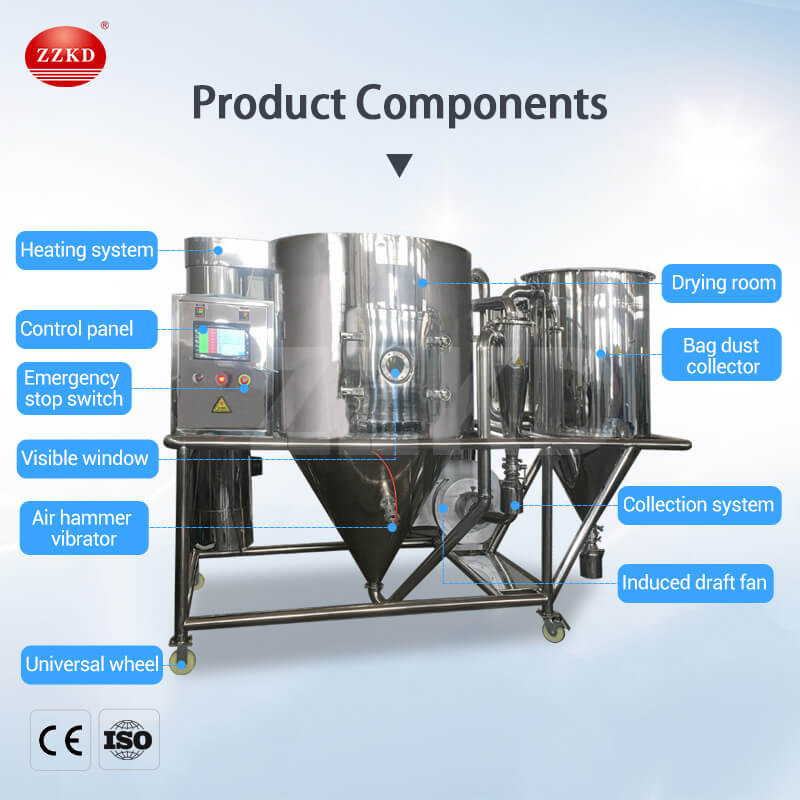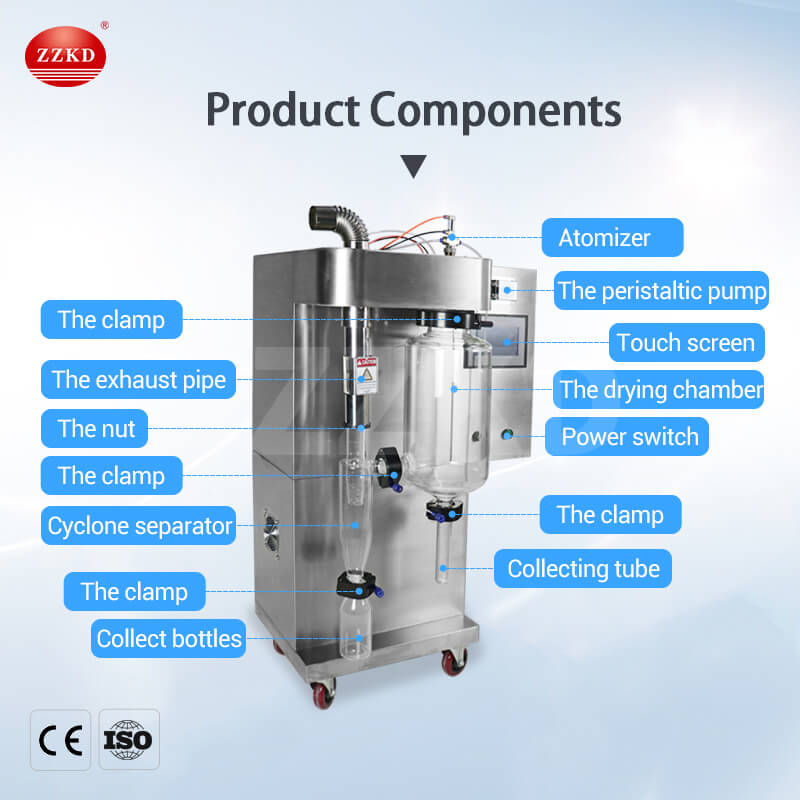how to use horizontal spray dryer machine?
For different materials, choose the corresponding atomizer, so that the finished product with good effect can be dried. The spray dryer price atomization, in fact, spray dryer atomization is related to product moisture, particle size, and wall stickiness. According to different products, the atomization method is also different. Many users use spray dryers. When encountering problems such as uneven product moisture, uneven particle size, and agglomeration and sticking to the wall of the equipment tower or cone, it is related to the moisture, particle size and sticking of the product.

Five factors affecting the drying effect of spray dryer
The dryer vaporizes and escapes the moisture in the material (generally refers to moisture or other volatile liquid components) by heating to obtain solid materials with a specified moisture content. The purpose of drying is for the needs of material use or further processing. Drying is actually a relatively simple process, but, in some cases, the particles simply cannot be dried completely. The reason for this is that some external factors affect the drying effect, including the following aspects:
1. Drying temperature: refers to the temperature of the air entering the drying barrel. Because of its physical properties, such as molecular structure, specific gravity, specific heat, moisture content and other factors, the drying temperature of each raw material has certain limitations. The local additives in the raw materials will volatilize and deteriorate or agglomerate, and if too low, some crystalline raw materials cannot reach the required drying conditions, such as: PC/120°C, ABS/80 to 95°C. In addition, insulation and heat preservation are required in the selection of dry barrels to avoid loss of drying temperature, resulting in lack of drying temperature or waste of energy.
2. Dew point: In the dryer, first remove the moist air to make it contain very low residual moisture (dew point). Then, reduce its relative humidity by heating the air. At this time, the vapor pressure of the dry air is lower. By heating, the water molecules inside the particles get rid of the binding force and diffuse to the air around the particles.
3. Time: In the air around the particles, it takes a certain amount of time for the absorption of heat and the diffusion of water molecules to the surface of the particles. Therefore, resin suppliers should specify the time it takes for a material to dry effectively at the proper temperature and dew point.
4. Air flow: The dry hot air transfers heat to the particles in the drying silo, removes the moisture on the surface of the particles, and then sends the moisture back to the dryer. Therefore, there must be enough air flow to heat the resin to the drying temperature and maintain this temperature for a certain period of time.
5. Air volume: The air volume takes away the medium of moisture in the raw materials, and the size of the air volume will affect the dehumidification effect. If the air volume is too large, the return air temperature will be too high, which will cause overheating and affect its stability. If the air volume is too small, it will not be able to completely take away the moisture in the raw materials. The air volume also represents the dehumidification capacity of the dehumidifying dryer.
Laboratory spray dryer atomization method
In a common spray dryer, there will be an atomizer. The quality of the atomizer directly affects the success of material drying. So, what are the common atomization methods? There are three kinds of conventional atomization methods: rotary atomization, pressure atomization and airflow atomization.
Let’s first introduce the rotary atomization. The characteristics of rotary atomization spray drying are that the single machine has a large production capacity (the spray volume can reach 200t/h), the feeding volume is easy to control, the operation flexibility is large, and it is widely used.
The characteristics of the pressure atomizer spray dryer are that it can produce coarse particles and is easy to maintain. Because the nozzle hole is small and easy to be blocked, the feed liquid must be strictly filtered. The nozzle holes are easy to wear and must be made of wear-resistant materials. There is also a new structure for pressure nozzles called pressure-air flow nozzles. It features a pressure nozzle in the center and an air flow nozzle in the surrounding ambient gap.
Atomization is divided into two stages:
The pressure nozzle first forms a liquid film, which is atomized by the airflow for the second time, making the droplets finer. The advantages of this type of nozzle are:
(1) Adjusting the pressure of the compressed air can adjust the diameter of the droplet, and the operation is simple;
(2) The material liquid with large output and high viscosity can also be atomized into fine mist droplets;
(3) If the compressed air is disabled, the original pressure nozzle can also be used.

Air atomizers are mainly used in laboratories and intermediate factories, and their power consumption is large. The material liquid that cannot be atomized by the first two atomizers may be atomized by the air-flow atomizer. High viscosity paste, paste and filter cake materials can be atomized with three-fluid nozzles.
The three atomization forms are not good or bad, only suitable or not. For different materials, choose the corresponding atomizer, so that the finished product with good effect can be dried.
If you want to know about our products, or want to buy our instruments, please feel free to contact us, we will be happy to help you.


